Indexing & Abstracting
Full Text
Case BlogDOI Number : 10.36811/ojae.2020.110003Article Views : 11Article Downloads : 10
Typological analysis for knowledge and Conservation of Spread Built Heritage: A case study
Rosa Agliata1* and Luigi Mollo2
1Research fellow at Department of Engineering, Università degli Studi della Campania “Luigi Vanvitelli”, via Roma, 9, Aversa (CE), Italy
2Associate Professor at Department of Engineering; Università degli Studi della Campania “Luigi Vanvitelli”, via Roma, 9, Aversa (CE), Italy
*Corresponding Author: Rosa Agliata, Research fellow at Department of Engineering, Università degli Studi della Campania “Luigi Vanvitelli”, via Roma, 9, Aversa (CE), Italy, Email: rosa.agliata@unicampania.it
Article Information
Aritcle Type: Case Blog
Citation: Rosa Agliata, Luigi Mollo. 2020. Typological analysis for knowledge and Conservation of Spread Built Heritage: A case study. Open J Archit Eng. 2: 01-08.
Copyright: This is an open-access article distributed under the terms of the Creative Commons Attribution License, which permits unrestricted use, distribution, and reproduction in any medium, provided the original author and source are credited. Copyright © 2020; Rosa Agliata
Publication history:
Received date: 28 December, 2019Accepted date: 06 January, 2020
Published date: 09 January, 2020
Abstract
Before carrying out any building refurbishment intervention, it is necessary to gather as much information as possible about the building itself and the built context surrounding it. This is a key factor in order to preserve the character of the built area in the design of the renovation intervention. For this reason, the first step to take is a field and archive survey to collect information and acquire knowledge about the existing shapes, materials, techniques and technologies. To do this, it may be helpful following a standardized procedure, consisting in simple steps, which allows identifying, at various scales (urban, building, technological, etc.) the invariant elements to be conserved, preserved and repeated in the project. This paper presents the application of a possible typical methodology to a real case belonging to the spread building heritage in Naples’ suburban area.
Keywords: Building typologies; Knowledge; Conservation; Spread built heritage
Introduction
A project with solid methodological bases, regardless of whether it is a new edification or a building renovation, starts from the investigation phase, finalized to the knowledge of the existing built heritage [1]. The output of this first operational step is to be used as a guide for the successive design choices [2]. When a new building is being constructed, it is sufficient to acquire information about the surrounding built area; for renovation projects instead, knowledge about the building itself is also needed to be able to compare the technical-constructive design choices to the data collected on site [3]. This process enables to identify the invariant typological elements characterizing the built environment [4] and reproduce them, more or less updated, in the project design, at all scales [5]. This way, one city can be renewed and transformed, even entirely, still preserving its particular, unique and unrepeatable historical marks [6,7]. In restoration projects, the study of the built heritage aimed to a better project design, although widely theorized, is not fully standardized [8] and even less applied, leaving instead most of the decisions to the designer's taste. In this work, a standard typological reading procedure is applied to a “choral building” located in the historical center of a town belonging to the suburban belt of Naples’ metropolitan area, in the perspective of a hypothetical rehabilitation operation. This simple and repeatable procedure is here split into three levels: urban, building and technological.
Case study
Urban scale
The case study is located in Calvizzano, a town set a few kilometers north of Naples, in the heart of a highly urbanized area called “Campania Plain” (Figure 1).
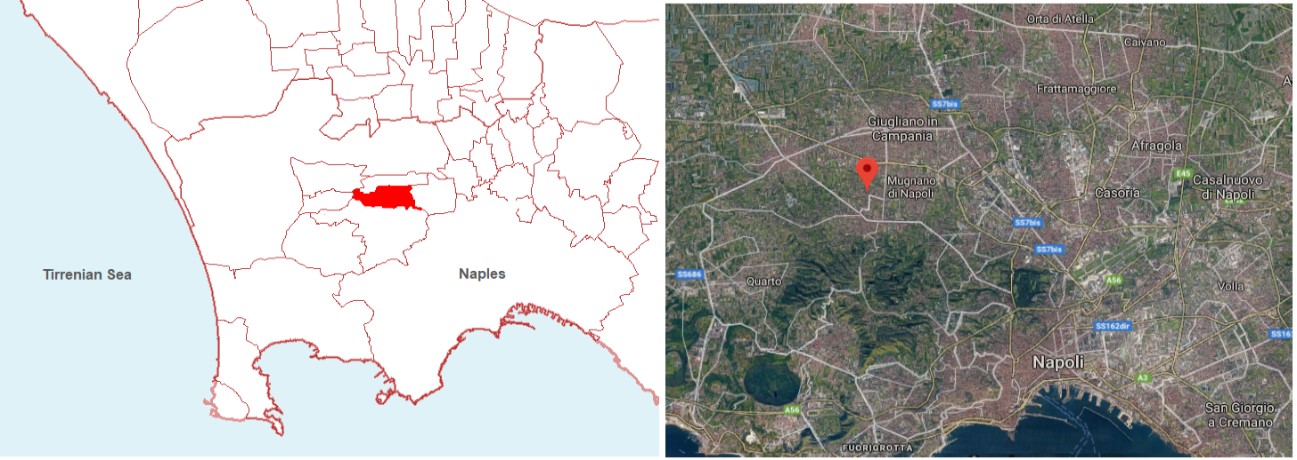
Figure 1: The left panel shows the position of the municipality of Calvizzano (in red) in relation to Naples; right panel shows the high-density urbanisation of the area with a location mark (in red) indicating the position of the town where case study is located.
The town has developed mostly along its main road axis, oriented in the East-West direction, following one of the directives of the ancient Roman centuriation [9] descending from the development of Giugliano’s castrum [10] and connected to the ancient Via Consolare Campana [11]. The municipality has the features of an ancient rural village, overwhelmed, in recent decades, by a chaotic urban transformation: the first urban settlement was founded in XV century as a fief of the Caracciolo family [12], developed around the ducal palace and church by welcoming the construction of buildings by small landowners linked to the feudal lords. Nowadays, the town has a relatively marginal functional location, due to its modest settlement and demographic dimensions compared to the neighboring urban centers. The studied building is located a few hundred meters away from the ducal palace, along the main street (Figure 2), and it is an example of the urban development of the area. It is constructed following a repetitive urbanistic scheme, popular at that time in Campania Plain: the classic street - court - garden linear layout [13]. (Figure 3), also used for the ducal palace. All buildings in the area were designed for the small rural nobility, thus being at the same time a productive unit (with granaries and cellars) and places for leisure and rest. According to the urban planning in force (1978), the studied building is placed inside the original urban core (A Zone – Historical Centre) which means that no modifications are allowed in the volume and the main façade during restoration interventions (Italian law no. 457/78), since it is considered as an area of historic, environmental and artistic interest (Figure 2).

Figure 2: Historical centre: aerial photo (left) and areas of cultural interest taken from the proposal for a new Municipal Urban Plan – 2017 (right). In both panels, the red circle indicates the position of the case study.
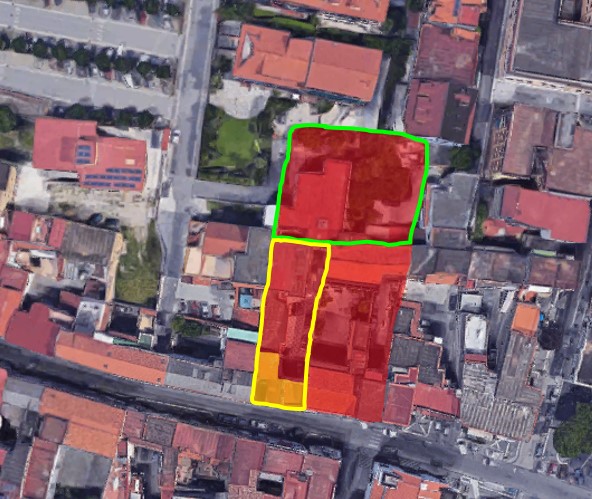
Figure 3: Case study (yellow L-shaped shading).
The boundaries of the current court to which the building belongs are also reported (solid yellow line) together with the size of the original court (red shading). Green solid line indicates the old garden size, now partially built. Although all the original courts, including the case study, are now subdivided into several housing units (Figure 3), the typological study at urban scale highlights the need that all renovation projects preserve the unity of the court scheme, even when operating on a single housing unit.
Building scale
The studied housing unit consists of three floors above ground and it is currently uninhabited. It develops in "L" shape (thus having two north sides and two east sides), oriented in north-south direction and forms, together with two other buildings, a three-sides court, closed on the east side by a wall. The wall separates the court from the adjacent lot, with which in the past it probably formed a larger court, with backyard garden, now partially built (Figure 3). The south side faces the street; the main north and east sides overlook the internal courtyard; the west side is adjacent to a building outside the court (Figure 4). The building plan is a simplification of the classic scheme called domus fabbricata, a characteristic residence, popular among the rural bourgeoisie in Campania Plain [14], which develops also in urban contexts according to the classic two-storey courthouse with an attic called suppenno on top. It is a modernized version of the well-known domus italica type [15]. In this layout, first floor was generally used as a residence, while the ground floor had a productive or trade end use. The suppenno was intended for storage of agricultural commodities and most of the time had typical arched windows [16]. The ground floor of the studied building, following this outline, consists of two rooms (called tabernae), once used for craft and commercial activities, with access from the street [17]. On the back of the two rooms there is a staircase leading to the upper floor, with a double entrance from the courtyard. Also, the first floor is constituted by two rooms, as big as the ones below, each with a balcony overlooking the street. On this floor, there is also a small bathroom of about 3 m2, with access directly from the stairwell (Figure 5, right panel).
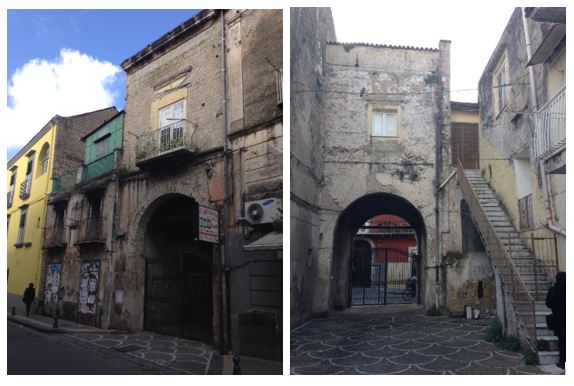
Figure 4: South view (left) and north view (right) of the case study.
Over time, probably around the end of the 19th century, the suppenno was replaced by a new floor and then it was rebuilt above the latter. The memory of this second suppenno, demolished for safety reasons in the 90s, when it had lost its original storage function, remains in two masonry tympana (Figure 6) and in a row of tiles, belonging to the removed pitched roof (Figure 4, right panel).
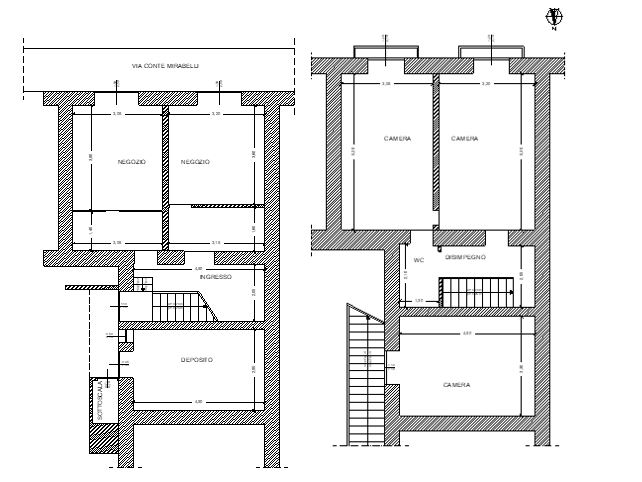
Figure 5: Ground floor plan (left) and first floor plan (right).
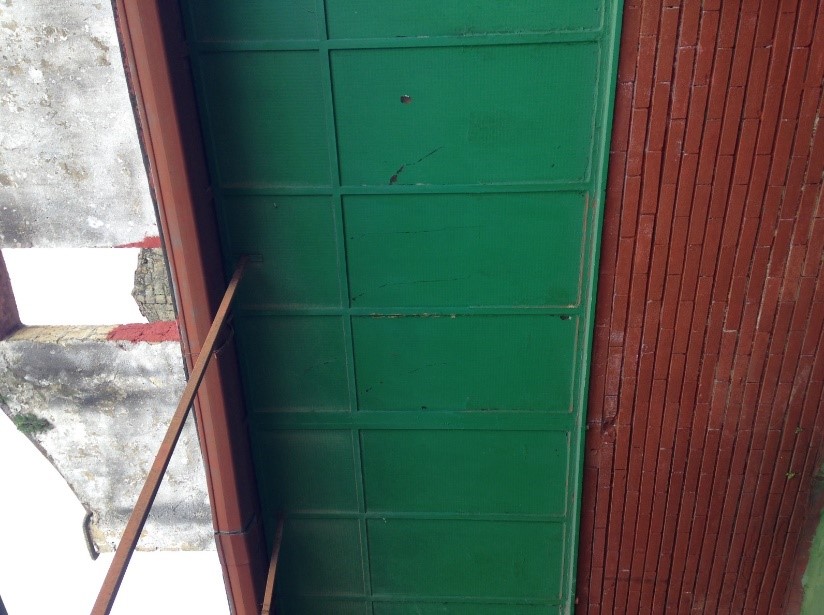
Figure 6: Tympanum above the veranda.
The access to the second floor is possible directly from the courtyard via a steep external staircase: rise and tread are 21 and 26 cm respectively (Figure 4, right panel). Also, second floor has 2 rooms with a small bathroom of about 4 m2. Initially, these two rooms were separated by an open terrace, through which it was possible to enter both of them. In the '70s, the terrace was partially closed by an unauthorized veranda (later condoned) that allowed, at the same time, a more comfortable entrance to the rooms through an indoor hallway and the creation of an additional room, used as a kitchenette (Figure 7).
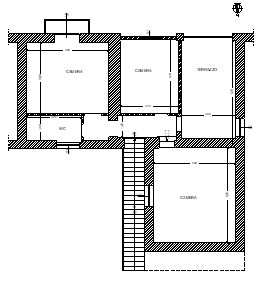
Figure 7: Second floor plan.
It is interesting to note that along the external staircase a further small mezzanine room has been built up, which can only be accessed by the staircase itself. The lack of a landing and the narrow stairway tread make the accessibility to the room quite poor (Figure 8). The typological invariants at building scale to be preserved are the independence of the floors, together with the commercial vocation of the rooms at the ground floor. Furthermore, the attic with pitched roof should be rebuilt, to restore the pre-existing suppenno.
Figure 8: Entrance to the external room.
Technological scale
From the constructive point of view, the building is the result of multiple layers added over time one on top of each other to meet the different rising needs, from the beginning of 19th century (ground floor and first floor) up to the 70's (second floor and suppenno). This is evident in the overlapping of different styles, materials and building techniques, which has generated peculiar situations, such as the variability of the floor thickness. The latter causes differences in the net internal height of the rooms (e.g. the rooms on the first floor) and in the heights of the walking floors. This happens also within the same floor: e.g., slabs on the first floor have a difference in height of 0.45 m and second floor ones differ to each other by 0.51 m, as remarkable from the steps in Figure 7. About the materials, the load-bearing walls are in rubble masonry made of yellow Neapolitan tuff, a volcanic material widely available in the area [18]; the most used mortar was a hydraulic pozzolana mortar, made with two parts (by volume) of pozzolana and one (or a little more) of grassello, until obtaining a light lead-colored mixture [19]. The roof slabs are made with wooden beams obtained from simple chestnut trunks, rough-hewn and arranged end-to-end (Figure 9), meaning alternating one end with the other so as to ensure, on each side, the same resistance [20]. A rough plank made of halved poles and covered by a 20/40 cm layer of mortar, on which the flooring was then laid, completed the floor [21]. The balconies on the first floor are made with marble slabs on iron supports called gattoni (Figure 4, left panel). The external staircase to access the second floor was built in the '60s in reinforced concrete following the rampant slab scheme. It replaces a pre-existing staircase (a collo d’oca), where a rampant barrel vault, leaning against the opposite wall, supported basalt steps.
Figure 9: Ground floor slab with wooden trunks.
Even the façade shows evidences of the modifications that took place over the years, like the cornices of the nineteenth-century façade, also bearing witness the original size of the French window (Figure 4). The presence of different but well-integrated materials and technologies suggests to respect this overlap in a possible rehabilitation operation by keeping the masonry load-bearing walls and using reinforced concrete or mixed wood-concrete floor slabs.
Conclusions
This work presents a methodological procedure to carry out a typological analysis of the built heritage at different levels, from the urban scale, to the building and technological ones. This type of investigation is aimed to identify typological invariants to be preserved when a refurbishment intervention is carried out. The procedure is applied to a real case study, a choral building dating back to the early XX century, located in the historical centre of a town set in Naples’ metropolitan area. The work has shown that the typological analysis, which is a method developed for the design of important restoration interventions, also works when applied, in a simplified way, to more modest structures, such as the spread built heritage. In particular, in the present work it has allowed to clearly recognize the typical features of the building at different scales, drawing the guidelines for its restoration, which do not preclude its vital, unavoidable and indispensable transformation.
References
1. Mollo L, Agliata R. 2013. Frammenti del passato nei contesti presenti: l'architettura rurale Basca. SABIEDRIBA, INTEGRACIJA, IZGLITIBA. 6: 107-113.
2. Tagliaventi G, Mollo L. 2003. Architecture in the age of globalization. 2: 1-128.
3. Caniggia G, Maffei GL. 2001. Architectural composition and building typology: interpreting basic building. 176. Ref.: https://bit.ly/2twGns0
4. Muratori S. 1967. Civiltà e territorio.Centro studi di storia urbanistica.
5. Kropf K. 2018. The handbook of urban morphology. John Wiley & Sons. Ref.: https://bit.ly/2QJ89tc
6. Oliveira V. 2019. Urban Forms, Agents, and Processes of Change. in: The Mathematics of Urban Morphology. 529-535. Ref.: https://bit.ly/39G5atU
7. Malighetti LE. 2016. Metodi e strategie per il recupero nuclei storici minori. Architettura tra tradizione e innovazione: il caso Svizzero di Wespi de Mueron Romeo Architetti. TECHNE: Journal of Technology for Architecture & Environment.12 .
8. Carbonara G. 1996. Trattato di restauro architettonico.
9. Rescigno C, Senatore F. 2009. Le città della piana campana tra IV e III sec. a.C. Dati storici e topografici. in atti del convegno: Verso la città. Forme insediative in Lucania e nel mondo italico fra IV e III sec. a.C., Venosa. Ref.: https://bit.ly/2ZVj1Iv
10. Libertini G. 2015. Strade di connessione fra Atella e i centri vicini in epoca romana. Aversa. Ref.: https://bit.ly/2QK5G1v
11. Galiero R. 1931. Calvizzano: dalle remote origini al IX anno del Littorio. Tipografia Rocco, Napoli.
12. Acanfora N. 2019. Saggio sugli usi, i costumi e la storia dei comuni della città metropolitana di Napoli. Book Sprint Edizioni.
13. Reccia G. 2009. Topografonomastica e descrizioni geocartografiche dei casali atellano-napoletani di Grumo e Nevano. Istituto di studi atellani Napoli. Ref.: https://bit.ly/2tx7ZwN
14. Mollo L. 2013. Studi e considerazioni sul rapporto fra tipologia edilizia e paesaggio urbano. Aversa.
15. Adam JP, Guidobaldi MP, Torelli M, et al. 1996. L'arte di costruire presso i Romani: materiali e tecniche. Longanesi.
16. Misuraca G, Boldi MA. 1900. L’arte moderna del fabbricare: trattato pratico ad uso degli ingegneri, costruttori, capimastri e studenti. Vallardi .
17. Breymann G. 1985. Trattato generale di costruzioni civili. Di Baio. Ref.: https://bit.ly/2Ql4UJp
18. Penta F. 1935. I materiali da costruzione nell’Italia Meridionale. Napoli.
19. Mollo L. 2004. Tecnologie costruttive aversane. Napoli.
20. Tagliaventi G. 2000. Tecniche e tecnologie dell'architettura fra eclettismo e storicismo. Alinea. Ref.: https://bit.ly/35oX4CN
21. Aveta A. 1987. Materiali e tecniche tradizionali nel napoletano: note per il restauro architettonico. Napoli.




















